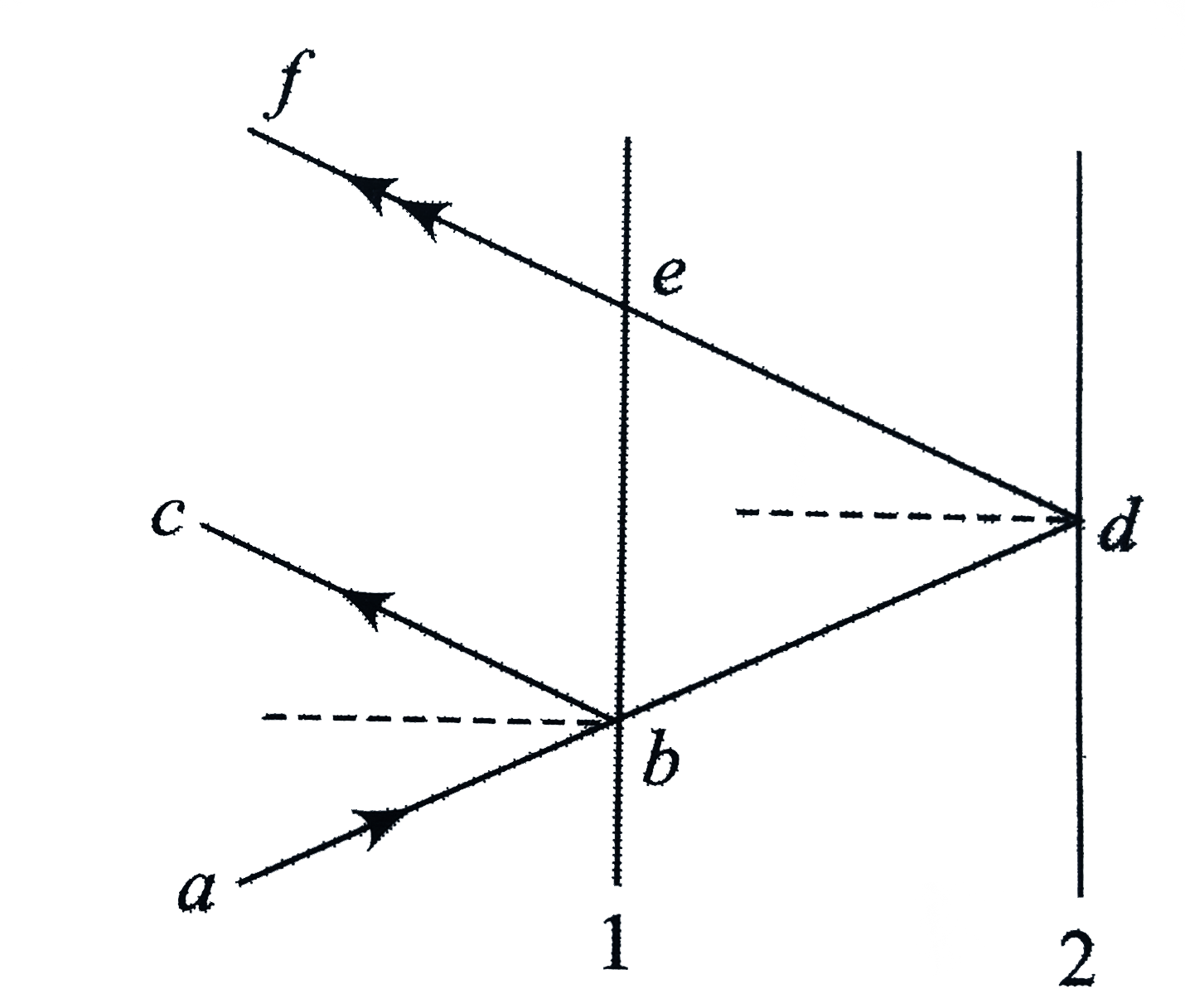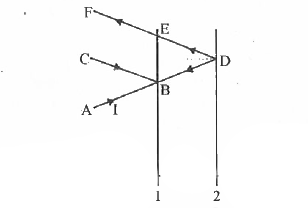_E01_107_Q01.png)
A narrow monochromatic beam of light of intensity I is incident on a galss plate as shown in figure. Another identical glass plate is kept close to the first one & parallel to it. Each glass plate reflects 25% of the light incident on it and transmits the remaining find the ratio of the minimum & the maximum intensities in the interference pattern formed by the two beams obtained after one reflection at each plate.Solution in Gujrati
The correct Answer is:1:49
_E01_107_S01.png)
Each plate reflects 25% and transmits 75∘ incident beam has an intensity I. this beam undergoes multiple reflections and refractions. The corresponding intensity after each reflection and refraction (transmission) are shown in figure.
Interference pattern is to take place between rays 1 and 2. I1=I/4 and I2=9I/64
∴IminImax=(√I1−√I2√I1+√I2)2=149
Topper's Solved these Questions
- BOOK - ALLEN CHAPTER - WAVE OPTICSEXERCISE - Exercise 5 A (Previous Years Questions)17videos
WAVE OPTICS
- BOOK - ALLEN CHAPTER - WAVE OPTICSEXERCISE - Exercise 5 B (Previous Years Questions)19videos
WAVE OPTICS
- BOOK - ALLEN CHAPTER - WAVE OPTICSEXERCISE - Exercise 4 A (Conceptual subjective Exercise)9videos
WAVE OPTICS
- BOOK - ALLEN CHAPTER - UNIT & DIMENSIONS, BASIC MATHS AND VECTOR EXERCISE - Exercise (J-A)7videos
UNIT & DIMENSIONS, BASIC MATHS AND VECTOR
Similar Questions
To demonstrate the phenomenon of interference, we require two sources which emit radiation ......
03:36View SolutionTwo beams of ligth having intensities I and 4I interface to produce a fringe pattern on a screen. The phase difference between the beams is π2 at point A and π at point B. Then the difference between the resultant intensities at A and B is
03:49View SolutionConsider interference between two sources of intensity I and 4I. Find out resultant intensity where phase difference is (i). π/4
(ii). π
(iii). 4π03:37View SolutionMatch List I with List II and select the correct answer using the codes given below the lists :
 05:25View Solution
05:25View SolutionA narrow monochromatic beam of light of intensity 1 is incident on a glass plate as shown in figure Another identical glass plate is kept close to the first one and parallel to it. Each glass plate reflects 25% of the light incident on it and transmits intensities in the interference pattern formed by two beams obtained after one reflection at each plate.
 View Solution
View Solution_E01_107_Q01.png)
A narrow monochromatic beam of light of intensity I is incident on a galss plate as shown in figure. Another identical glass plate is kept close to the first one & parallel to it. Each glass plate reflects 25% of the light incident on it % transmits the remaining find the ratio of the minimum & the maximum intensities in the interference pattern formed by the two beams obtained after one reflection at each plate.05:31View SolutionA beam of light strikes a glass plate at an angle of incident 60∘ and reflected light is completely polarised than the refractive index of the plate is-
08:07View SolutionA narrow monochromatic beam of light of intensity I is incident on a glass plate. Another identical glass plate is kept close to the first one and parallel to it. Each plate reflects 25% of the incident light and transmits the remaining. Calculate the ratio of minimum and maximum intensity in the interference pattern fromed by two beams obtained after reflection from each plate.
View SolutionA parallel beam of sodium light of wavelength 5896 Å is incident at angle 30^(@) . Find the minimum thickness of the glass plate for which the transmitted beam appears to be dark.
View SolutionA parallel beam of light of intensity I is incident on a glass plate. 25% of light is reflected in any reflection by upper surface and 50% of light is reflected by any reflection from lower surface. Rest is refracted The ratio of maximum to minimum intensity in interference region of reflected rays is
05:43View SolutionI तीव्रता का एक संकीर्ण एकवर्णी प्रकाश पुंज चित्रानुसार काँच की एक प्लेट पर आपतित होता है। प्रत्येक प्लेट इस पर आपतित 25% प्रकाश को परावर्तित तथा शेष को पारगमित के देती है। प्रत्येक प्लेट से एक परावर्तन के बाद प्राप्त पुंज से निर्मित व्यतिकरण प्रतिरूप में न्यूनतम और अधिकतम तीव्रता का अनुपात ज्ञात कीजिए ।
 08:07View Solution
08:07View Solutionचित्र 10.36 में तीव्रता I का एक संकीर्ण एकवर्णी प्रकाश पुंज काँच की एक प्लेट पर आपतित होता है | एक दूसरी समरूप प्लेट, पहली प्लेट के पास उसके समान्तर रखी गयी है | प्रत्येक प्लेट, इस पर आपतित प्रकाश का 25% भाग परावर्तित तथा शेष भाग पारगमित करती है | दोनों प्लेटों से परावर्तन के फलस्वरूप प्राप्त व्यतिकरण प्रतिरूप में न्यूनतम तथा अधिकतम तीव्रता का अनुपात ज्ञात कीजिए |
06:00View SolutionA parallel beam of light of intensity I_0 is incident on a coated glass plate . IF 25% of the incident light is reflected from the upper surface and 50 % of light if reflected from the glass plate , the ratio of maximum to minimum intensity in the interference region of the reflected light is
01:50View SolutionA parallel beam of light of intensity I∘ is incident on a coated glass plate. If 25% of the incident light is reflected from the upper surface and 50% of light is reflected from the lower surface of the glass plate, the ratio of maximum to minimum intensity in the interference region of the reflected light is
02:58View SolutionI तीव्रता का एक संकीर्ण एकवर्णी प्रकाश पुंज चित्रानुसार काँच की एक प्लेट पर आपतित होता है | एक दूसरी समरूप प्लेट पहली प्लेट के पास उसके समांतर रखी गयी है | प्रत्येक प्लेट इस पर आपतित 25% प्रकाश को परावर्तित तथा शेष को पारगमित कर देती है | प्रत्येक प्लेट से एक परावर्तन के बाद प्राप्त पुंज से निर्मित व्यतिकरण प्रतिरूप में न्यूनतम और अधिकतम तीव्रता का अनुपात ज्ञात कीजिए |
 04:52View Solution
04:52View SolutionTwo thin glass plates are placed parallel to each other such that distance between them is very small. Each glass plate reflects 25% of incident energy and transmits remaining 75% Light beam is incident on this system. Consider the interference of two light beams obtained after one reflection from each glass plate. Calculate ratio of the maximum to minimum intensity.
08:13View Solution

